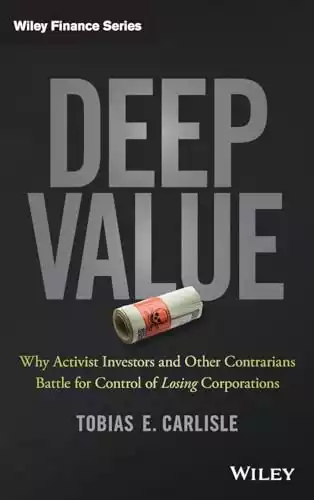Overview : Deep Value Book
-
Book Title: Deep Value: Why Activist Investors and Other Contrarians Battle for Control of Losing Corporations
-
Author: Tobias E. Carlisle
-
Publication Date: The original edition was published in 2014.
-
Rating: 4.5
-
price: $57.29
-
Pages: 256
Author Information
Deep Value: Why Activist Investors and Other Contrarians Battle for Control of Losing Corporations is authored by Tobias E. Carlisle, a well-known investor and advocate of contrarian and value investing. In this book, Carlisle delves into the strategies activist investors use to unlock value in struggling companies, offering insights into deep value investment opportunities.
Introduction to Deep value Book By Tobias E. Carlisle
Deep Value by Tobias E. Carlisle offers a compelling exploration of contrarian investing, focusing on overlooked stocks and market inefficiencies. here is deep value book review highlights Carlisle’s evidence-backed approach to value investing, showcasing strategies that challenge conventional wisdom and emphasize patience and discipline for maximizing returns in undervalued opportunities.
Deep Value Book Summary
Carlisle, a renowned figure in quantitative value investing, presents a compelling case for investing in seemingly underperforming or "losing" companies. The core thesis of "Deep Value" is that markets frequently misprice these unloved stocks, creating lucrative opportunities for savvy investors.
"The market often misprices companies that are considered losers, creating opportunities for astute investors to capitalize on these misunderstood stocks."
Key Insight of Deep Value Book:
- The mechanics of deep value investing
- The role of activist investors in unlocking value
- The psychological aspects of contrarian investing
- Case studies and empirical evidence supporting the deep value approach
Analysis of Themes: Diving Deep into Value
The Essence of Deep Value Investing
Carlisle argues that companies priced for failure often offer a substantial margin of safety. By meticulously analyzing these businesses, investors can potentially reap significant returns as the market eventually recognizes their true value.
Activist Investors: Catalysts for Change
A significant portion of the book is dedicated to activist investors like Carl Icahn and Bill Ackman. Carlisle provides a behind-the-scenes look at how these investors operate, influencing management and strategic direction to unlock hidden value.
The Contrarian Mindset
"Deep Value" emphasizes the psychological fortitude required to succeed in this investing style. Carlisle discusses behavioral finance aspects, such as herd behavior and cognitive biases, that often lead to market inefficiencies.
Writing Style: Engaging and Accessible
Carlisle's writing is both informative and engaging, making complex financial concepts accessible to a broad audience. He skillfully blends theoretical frameworks with practical examples, creating a narrative that's both educational and entertaining.
Strengths and Weaknesses of Deep Value Book
Strengths:
- Robust empirical evidence and case studies
- In-depth analysis of activist investing strategies
- Clear explanations of complex financial concepts
Weaknesses:
- May be too focused on U.S. markets for some international readers
- Could benefit from more discussion on potential risks of deep value investing
Deep Value Related Book
While "Deep Value" shares some similarities with classic value investing texts like Benjamin Graham's "The Intelligent Investor," it distinguishes itself by focusing on the most extreme cases of undervaluation. Compared to more recent works like Joel Greenblatt's "The Little Book That Beats the Market," Carlisle's book offers a more in-depth look at the mechanics of value creation through activist intervention.
Relevance to Current Market Trends
In today's market, dominated by growth stocks and passive investing, "Deep Value" offers a compelling counter-narrative. As investors seek alternatives in a potentially overvalued market, Carlisle's insights on finding value in overlooked companies become increasingly relevant.
Deep Value Book Highlighted Points
Contrarian Investing: The book advocates for contrarian investing, targeting undervalued companies that others overlook.
Value in Distressed Assets: Highlights how losing corporations often hold hidden value that can be unlocked with strategic intervention.
Activist Investors’ Role: Activist investors take control of struggling companies to implement changes, aiming for profitable turnarounds.
Deep Value Approach: Focuses on investing in companies trading below intrinsic value, offering significant long-term gains.
Patience and Strategy: Emphasizes patience, thorough research, and a strategic mindset for successful deep value investing.
Risk and Reward: Undervalued investments are high-risk but can lead to substantial rewards if executed correctly.
Conclusion: A Valuable Addition to Any Investor's Library
"Deep Value" is a thought-provoking and insightful exploration of contrarian investing. Carlisle challenges conventional wisdom and provides a robust framework for understanding the potential rewards of investing in the market's most unloved corners.
For investors looking to diversify their strategies or gain a deeper understanding of value investing, this book is an essential read. It not only guides readers in identifying undervalued opportunities but also instills the mindset necessary for long-term investing success.
Whether you're a seasoned investor or just starting your financial journey, "Deep Value" offers valuable insights that can help shape your investment philosophy and potentially lead to significant financial rewards.
Ready to Dive into Deep Value Investing?
If you're intrigued by the concepts discussed in this review and want to explore deep value investing further, consider purchasing "Deep Value" by Tobias E. Carlisle. Click the link below to get your copy and start your journey into the world of contrarian investing:
Get Your Copy of "Deep Value" on Amazon
(Note: This is an affiliate link. If you make a purchase, we may earn a small commission at no additional cost to you. Thank you for supporting our work! In conclusion, this article has provided an overview of the topic at hand.





